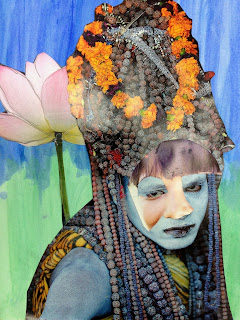
The idea of collage and school assignments has always left a bad taste in my mouth. My experience has been seeing poster boards divided into food groups by elementary school students with poorly cut magazine pictures sloppily glued into poor compositions.
Introducing art students to the Harlem Renaissance master, Romare Bearden, increases the chance that some decent looking images come out of a collage assignment. I had my students look at many of his works, like the poster above, (The Dove, 1964) and talk about how crowded his urban images were compared to the rural counterparts.
We talk about not just stealing the face of a recognizable celebrity but also creating an original face or figure through morphing several people into one. If they play it too safe, I tell them that it hasn't reached the Bearden level of "wonkiness" yet. It helps to give numbers; for example, each face should be made up of at least three different photographs. The student piece to the right began with water color. Bearden often painted paper to incorporate to his collage pieces.
Symbolism is important to communicate meaning in literature, music and art. Bearden often used a train in his artwork. This is a symbol for the Underground Railroad, as well as northern migration of African Americans in general. Trains also provided decent jobs and upward mobility for many African Americans in our country's history. Two of my students chose to use lighthouses (see below) as their symbols of things that enlighten or bring one into life's safe harbors.
Romare Bearden was truly a Renaissance man; he worked in many mediums of art, including literature and music. He spent a lot of time at jazz clubs, and was acquainted with some of the greats, like Duke Ellington. Bearden would sometimes draw the music he loved so much, with lines and marks. I love when music directly ties into art lessons. My students enjoyed listening to some big band jazz while they worked. The music helped them stay engaged in their projects.
 The student who made this painting has prosthetic eyes. The latex paint dots and puddles were somewhat tactile. When she felt her painting the next day she said, "Oooooo. This is really nice!"
The student who made this painting has prosthetic eyes. The latex paint dots and puddles were somewhat tactile. When she felt her painting the next day she said, "Oooooo. This is really nice!"

















